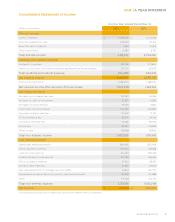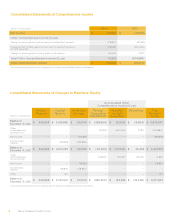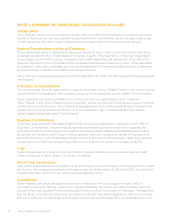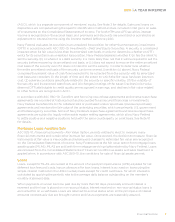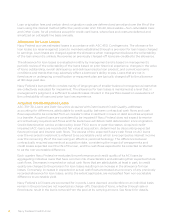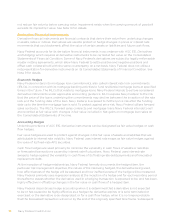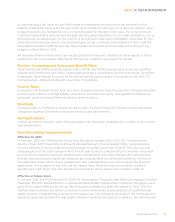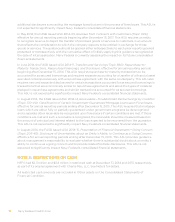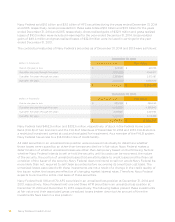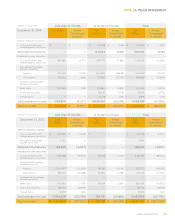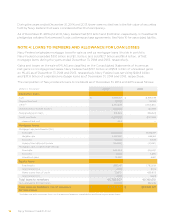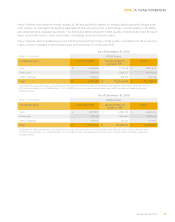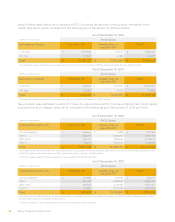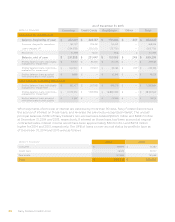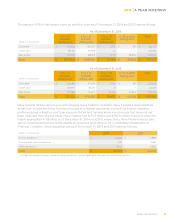Navy Federal Credit Union 2014 Annual Report Download - page 29
Download and view the complete annual report
Please find page 29 of the 2014 Navy Federal Credit Union annual report below. You can navigate through the pages in the report by either clicking on the pages listed below, or by using the keyword search tool below to find specific information within the annual report.Financial Section 11
2014 | A YEAR IN REVIEW
to discontinuing a fair value or cash flow hedge, the derivative will continue to be recorded on the
balance sheet at fair value with changes in fair value included in earnings. For a discontinued fair value
hedge, the previously hedged item is no longer adjusted for changes in fair value. For a discontinued
cash flow hedge that is discontinued because the forecasted transaction is no longer probable to occur,
the previously unrealized gain or loss in AOCI is recognized in earnings immediately; otherwise, for the
other discontinuing type events, the unrealized gain or loss continues to be deferred in AOCI until the
forecasted transaction aects earnings. Navy Federal did not discontinue hedge accounting for any
hedges in either 2014 or 2013.
All derivative financial instruments are recognized at fair value and classified as Other assets or Other
liabilities on the Consolidated Statements of Financial Condition. See Note 9 for details.
Pension Accounting and Retirement Benefit Plans
Navy Federal has defined benefit pension plans, 401(k) and 457(b) savings plans, and a non-qualified
supplemental retirement plan. Navy Federal also provides a contributory group medical plan for retired
employees. Navy Federal accounts for its defined benefit pension plans in accordance with ASC 715,
Compensation—Retirement Benefits. See Note 17 for details.
Income Taxes
Pursuant to the Federal Credit Union Act, Navy Federal is exempt from the payment of federal and state
income taxes. NFFG is a limited liability corporation, and thus is an entity “disregarded for federal tax
purposes” under an Internal Revenue Service revenue ruling.
Dividends
Dividend rates on members’ accounts are set by Navy Federal’s Board of Directors, and dividends are
charged to expense. Dividends on all share products are paid monthly.
Reclassifications
Certain amounts in the prior year’s financial statements have been reclassified to conform to the current
year presentation.
New Accounting Pronouncements
Eective for 2014
In February 2013, the FASB issued Accounting Standards Update (ASU) 2013-02, Comprehensive
Income (Topic 220): Reporting of Amounts Reclassified out of Accumulated Other Comprehensive
Income, eective for annual reporting periods beginning after December 15, 2013. This ASU requires
disaggregation of the total change in AOCI for the year by each corresponding net income component
and a further breakdown between reclassification adjustments and other changes during the period.
Entities must also present significant reclassification adjustments by component either on the face of
the statement where net income is presented or as a separate disclosure in the notes to the financial
statements. The adoption of this ASU did not impact Navy Federal’s financial condition, results of
operations or cash flows. The new disclosures required by this guidance are included in Note 19.
Eective in Future Years
In January 2014, the FASB issued ASU 2014-04, Receivables—Troubled Debt Restructurings by Creditors
(Subtopic 310-40): Reclassification of Residential Real Estate Collateralized Consumer Mortgage Loans
upon Foreclosure, eective for annual reporting periods beginning after December 15, 2014. This ASU
clarifies when a creditor should be considered to have received physical possession of residential real
estate property collateralizing a consumer mortgage loan. Upon physical possession, the mortgage loan
should be derecognized and the real estate collateral should be recognized. In addition, the ASU requires




